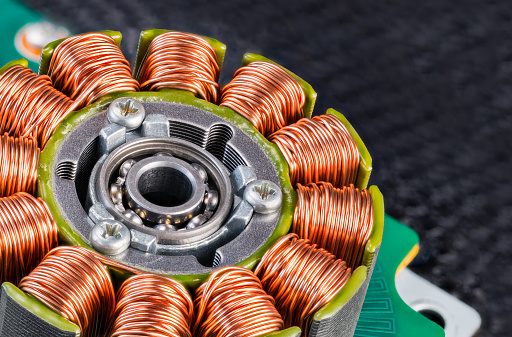Copper is a vital metal that humans have used for thousands of years, and its importance has only increased over time. This versatile metal is known for its excellent thermal and electrical conductivity, malleability, durability, and corrosion resistance. Copper is also a naturally occurring element widely available and easily extracted, making it a vital metal and an essential component in many applications.
The electrical industry employs copper as one of its primary materials. Due to their ability to transfer electricity over long distances with minimum energy loss, copper wires are vital metal components of power grids and telecommunications networks. Due to its superior conductivity and durability, copper is used extensively in electrical motors, transformers, and other electrical components.
The construction industry frequently uses copper. Its malleability and ductility make it the ideal material for roofing, cladding, and plumbing pipes. Heating and cooling systems use copper because of its excellent thermal conductivity, which allows it to serve as a dependable heat conductor.
In addition to its many functional uses, people have long used copper for ornamental purposes. People prefer copper for jewelry, sculpture, and other works of art due to its warm, rich hue and brilliance.
Copper is a vital metal that has played a significant role in human history and continues to be essential to modern society. Moreover, its excellent conductivity, durability, and antimicrobial properties make it a vital metal in various applications, from electrical systems to healthcare. While the demand for copper continues to increase, you must prioritize sustainable mining and extraction practices to minimize the environmental impacts of this vital metal. Continue reading this article for more information to find out why copper is a necessary metal.
Conductivity
Copper is known for its exceptional electrical conductivity, which is the ability of a material to conduct electricity. It is one of the most conductive metals, with only silver having a higher electrical conductivity. The high electrical conductivity of copper makes it an ideal choice for electrical wiring and circuitry. Copper is used to conducting electricity over long distances with minimal energy loss.
The atomic structure of copper is the reason for its excellent conductivity of electricity. One can produce a flow of electrons or an electrical current by removing the one outer electron of a copper atom from its valence shell. Copper has a high electrical conductivity due to its structural makeup, which enables the free passage of numerous electrons.
The atomic structure of copper is responsible for its excellent electrical conductivity. The valence shell of copper contains a single outer electron that is easily removable, directing the creation of a flow of electrons or an electrical current. The structure of copper facilitates a large number of free electrons to move through the metal, resulting in high electrical conductivity.
Malleability
Copper is a flexible metal that can be stretched and molded into elaborate patterns without breaking. It increases the likelihood of producing spires, steeples, musical instruments, bowls, bed frames, and various other functional and beautiful items. The malleability of copper makes it possible to employ thin wires to transfer currents in automobiles, computers, televisions, lighting, and other electronic devices.
Durability
One of copper’s most important benefits over other metals is its durability. It is a fantastic option for various applications because of its strong corrosion and wear resistance. Copper is a common material for plumbing because it can tolerate high pressures, chilly temperatures, and water exposure without rusting or degrading. Because copper is also desirable for roofing because of its durability and ability to withstand harsh weather conditions for an extended period without severely degrading.
In addition, copper’s extraordinary toughness has made it a popular material for industrial machinery building. Therefore it can withstand challenging circumstances like extreme heat, heavy loads, and constant vibrations without malfunctioning.
Moreover, with its excellent conductivity and longevity, copper is also utilized in numerous electrical parts and wiring, offering a durable and dependable option for various applications.
Aesthetics
The elegance and beauty of copper have captivated people for centuries. Delivering innovative and appealing architectural and design solutions while retaining traditional aesthetics is its purpose.
The attractive appearance of copper and its alloys gives all their applications a more upscale beauty, quality, and prestige. Unsurprisingly, copper is a frequent choice for decorative and architectural designs due to its attractive appearance and unique attributes.
Anti-Microbial Properties
Natural antibacterial qualities in copper allow it to destroy or stop the growth of germs like bacteria, viruses, and fungi.
People have known about the unique property of copper for thousands of years and have utilized it in various applications. Egyptians, for example, used copper for sterilizing wounds in ancient times. Today, in modern-day healthcare settings, copper surfaces are used to reduce the risk of infection.
Microorganisms are instantly exposed to copper ions when they touch a copper surface. It can penetrate the cell wall and damage the cell membrane, destroying the organism. Copper can also stop the genetic transmission of germs, which further slows the spread of infection.
Being Able to Recycle Copper
Recycling copper is possible without compromising its quality or performance. This quality can lower carbon dioxide emissions and conserve energy and precious natural resources while assisting in meeting the annual demand for copper.
Secondary copper production, also known as copper recycling, uses 85% less energy than primary copper production. In addition, two-thirds of the copper extracted since 1900 is still in use today, typically in electrical applications. Around the world, recycled copper made about 35% of the copper used.
However, there has to be more copper available for use due to the rising demand for it.
Population growth, product innovation, and economic development contribute to this need. These and the extended lifespan of most copper goods necessitate a mix of primary prod and secondary production.
Key Takeaway
Due to its unique combination of quality, copper is a vital metal. Moreover, this quality is a fundamental component of many industries, including plumbing, electrical, building, and healthcare. As technology develops and the value of sustainable resources rises, copper’s significance will only increase.





